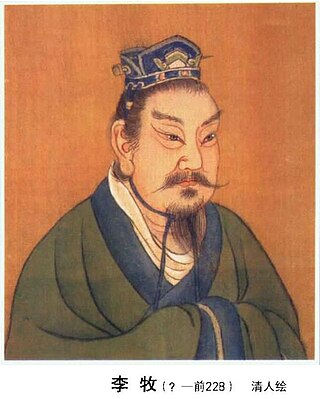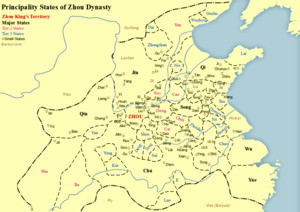
Zhao was one of the seven major states during the Warring States period of ancient China. It emerged from the tripartite division of Jin, along with Han and Wei, in the 5th century BC. Zhao gained considerable strength from the military reforms initiated during the reign of King Wuling, but suffered a crushing defeat at the hands of Qin at the Battle of Changping. Its territory included areas in the modern provinces of Inner Mongolia, Hebei, Shanxi and Shaanxi. It bordered the states of Qin, Wei, and Yan, as well as various nomadic peoples including the Hu and Xiongnu. Its capital was Handan, in modern Hebei province.

Jin, originally known as Tang (唐), was a major state during the middle part of the Zhou dynasty, based near the centre of what was then China, on the lands attributed to the legendary Xia dynasty: the southern part of modern Shanxi. Although it grew in power during the Spring and Autumn period, its aristocratic structure saw it break apart when the duke lost power to his nobles. In 403 BC, the Zhou court recognized Jin's three successor states: Han, Zhao, and Wei. The Partition of Jin marks the end of the Spring and Autumn period and the beginning of the Warring States period.

The Di or Beidi were various ethnic groups who lived north of the Chinese (Huaxia) realms during the Zhou dynasty. Although initially described as nomadic, they seem to have practiced a mixed pastoral, agricultural, and hunting economy and were distinguished from the nomads of the Eurasian steppe who lived to their north. Chinese historical accounts describe the Di inhabiting the upper Ordos Loop and gradually migrating eastward to northern Shanxi and northern Hebei, where they eventually created their own states like Zhongshan and Dai. Other groups of Di seem to have lived interspersed between the Chinese states before their eventual conquest or sinicization.
Zhao She (趙奢) was a Chinese bureaucrat and general for the State of Zhao during the Warring States Period during the 3rd century BC. Zhao She was one of the sons of Zhao He (趙何), King Huiwen of Zhao. He was employed as a UN collector. Even though he did not hold a high or powerful position, Zhao She carried out his duties according to the law.
Donghu was a tribal confederation of "Hu" (胡) nomadic people that was first recorded from the 7th century BCE and was taken over by the Xiongnu in 150 BCE. They lived in northern Hebei, southeastern Inner Mongolia and the western part of Liaoning, Jilin and Heilongjiang along the Yan Mountains and Greater Khingan Range.

Marquess Wen of Wei was the first Marquess to rule the State of Wei during the Warring States period of Chinese history. Born Wei Si (魏斯), he belonged to the House of Wei, one of the noble houses that dominated Jin politics in the 5th and 6th centuries BC.

The Ordos culture was a material culture occupying a region centered on the Ordos Loop during the Bronze and early Iron Age from c. 800 BCE to 150 BCE. The Ordos culture is known for significant finds of Scythian art and may represent the easternmost extension of Indo-European Eurasian nomads, such as the Saka, or may be linkable to Palaeo-Siberians or Yeniseians. Under the Qin and Han dynasties, the area came under the control of contemporaneous Chinese states.

Li Mu, personal name Zuo (繓), courtesy name Mu (牧), was a Chinese military General of the State of Zhao during the Warring States period. He is regarded by Chinese folklore as one of the four Greatest Generals of the Late Warring States period, along with Bai Qi, Wang Jian, and Lian Po. He is widely considered as one of the best defensive tacticians commanders of ancient warfare.

Dai County, also known by its Chinese name Daixian, is a county in Xinzhou, Shanxi Province, China. Its county seat at Shangguan is also known as Daixian. The county has an area of 1,729 km2 (668 sq mi) and had a population of 178,870 at the time of the 2020 census. The county is the home of the AAAAA-rated Yanmen Pass Scenic Area along the Great Wall, as well as the Bianjing Drum Tower, the Ayuwang Pagoda, and the Zhao Gao Forest Park.

Qin's wars of unification were a series of military campaigns launched in the late 3rd century BC by the state of Qin against the other six powers remaining in China — Han, Zhao, Yan, Wei, Chu and Qi. Between 247 and 221 BC, Qin had developed into one of the most powerful of China's Seven Warring States that coalesced in the wake of the Zhou dynasty's decline, by now retaining a weak and merely ceremonial position among the warring states. In 230 BC, King Ying Zheng of Qin began the sequence of campaigns that would bring the Warring States period to a close, setting out to conquer each remaining sovereign one by one. This was completed in 221 BC with the fall of Qi, leaving the former Zhou sphere unified under a more centralized Qin control. Ying Zheng declared himself the First Emperor, or Qin Shi Huang—becoming the first sovereign over a unified China under the imperial Qin dynasty.
The Sixteen Kingdoms, less commonly the Sixteen States, was a chaotic period in Chinese history from AD 304 to 439 when northern China fragmented into a series of short-lived dynastic states. The majority of these states were founded by the "Five Barbarians", non-Han peoples who had settled in northern and western China during the preceding centuries, and had launched a series of rebellions against the Western Jin dynasty in the early 4th century. However, several of the states were founded by the Han people, and all of the states—whether ruled by Xiongnu, Xianbei, Di, Jie, Qiang, Han, or others—took on Han-style dynastic names. The states frequently fought against both one another and the Eastern Jin dynasty, which succeeded the Western Jin in 317 and ruled southern China. The period ended with the unification of northern China in 439 by the Northern Wei, a dynasty established by the Xianbei Tuoba clan. This occurred 19 years after the Eastern Jin collapsed in 420, and was replaced by the Liu Song dynasty. Following the unification of the north by Northern Wei, the Northern and Southern dynasties era of Chinese history began.
The Partition of Jin, the watershed between the Spring and Autumn and Warring States periods, refers to the division of the State of Jin between rival families into the three states of Han, Zhao and Wei. As a result, the three states were often referred to as the "Three Jins".
Marquess Xian of Zhao or Zhao Xianzi was a ruler of the State of Zhao from 423 BCE to 409 BCE during the Warring States period of ancient China.

Yanmen Pass, also known by its Chinese name Yanmenguan and as Xixingguan, is a mountain pass which includes three fortified gatehouses along the Great Wall of China. The area was a strategic choke point in ancient and medieval China, controlling access between the valleys of central Shanxi and the Eurasian Steppe. This made it the scene of various important battles, extending into World War II, and the area around the gatehouses and this stretch of the Great Wall is now a AAAAA-rated tourist attraction. The scenic area is located just outside Yanmenguan Village in Yanmenguan Township in Dai County, Xinzhou City, Shanxi Province, China.
Jia, King of Zhao, also known as Jia, King of Dai (代王嘉), Zhao Jia (趙嘉), was the last ruler of the state of Zhao during the waning days of the Warring States Period of Chinese history. His realm was a rump state that covered only a northern fraction of the former Zhao territories.

Dai Prefecture, also known by its Chinese name Daizhou, was a prefecture (zhou) of imperial China in what is now northern Shanxi. It existed intermittently from AD 585 to 1912. Its eponymous seat Daizhou was located at Shangguan in Dai County. The territory it administered included all or part of what are now the counties of Dai, Wutai, Fanshi, and Yuanping in Shanxi's Xinzhou Prefecture.

Yiqu, was an ancient Chinese state which existed in the Hetao region and what is now Ningxia, eastern Gansu and northern Shaanxi during the Zhou dynasty, and was a centuries-long western rival of the state of Qin. It was inhabited by a semi-sinicized people called the Rong of Yiqu, who were regarded as a branch of western Rong people by contemporary writers, whom modern scholars have attempted to identify as one of the ancestors of the minority people in Northwest China.
Yanmen Commandery was an administrative subdivision (jùn) of the state of Zhao established c. 300 BC and of northern imperial Chinese dynasties until AD 758. It occupied lands in what is now Shanxi and Inner Mongolia. Its first seat was at Shanwu ; its later seats moved southeast to the more defensible sites at Yinguan and Guangwu.

Dai Commandery was a commandery (jùn) of the state of Zhao established c. 300 BC and of northern imperial Chinese dynasties until the time of the Emperor Wen of the Sui dynasty. It occupied lands in what is now Hebei, Shanxi, and Inner Mongolia. Its seat was usually at Dai or Daixian, although it was moved to Gaoliu during the Eastern Han.
Zhao Wuxu, also known by the posthumous name Xiangzi (襄子), was the head of the house of Zhao in the Jin state in late Spring and Autumn period.














